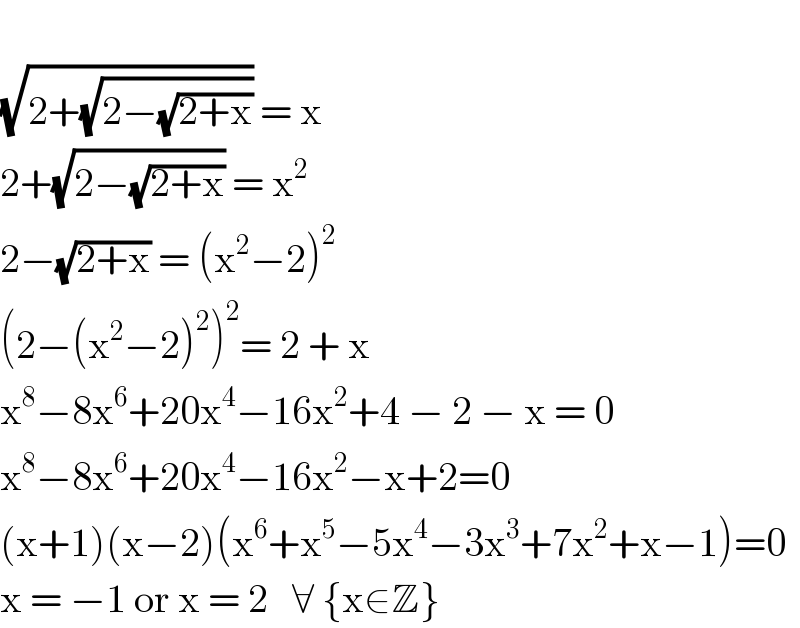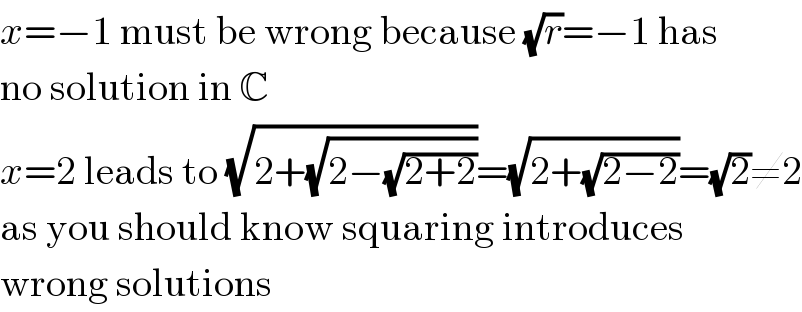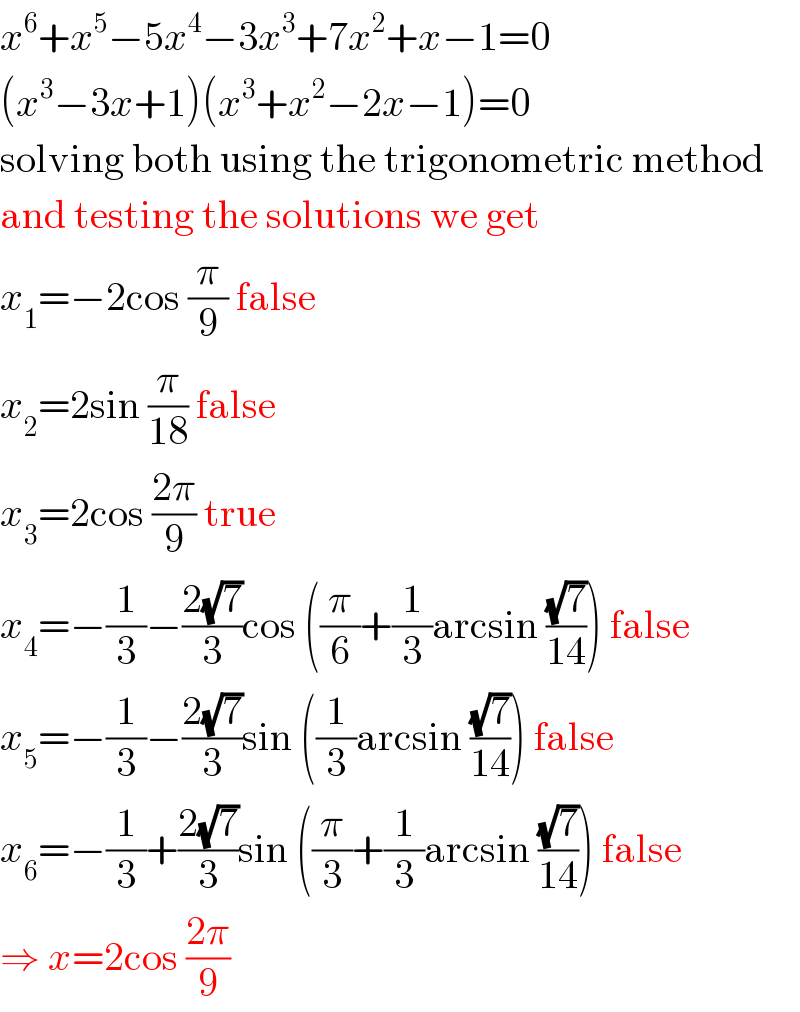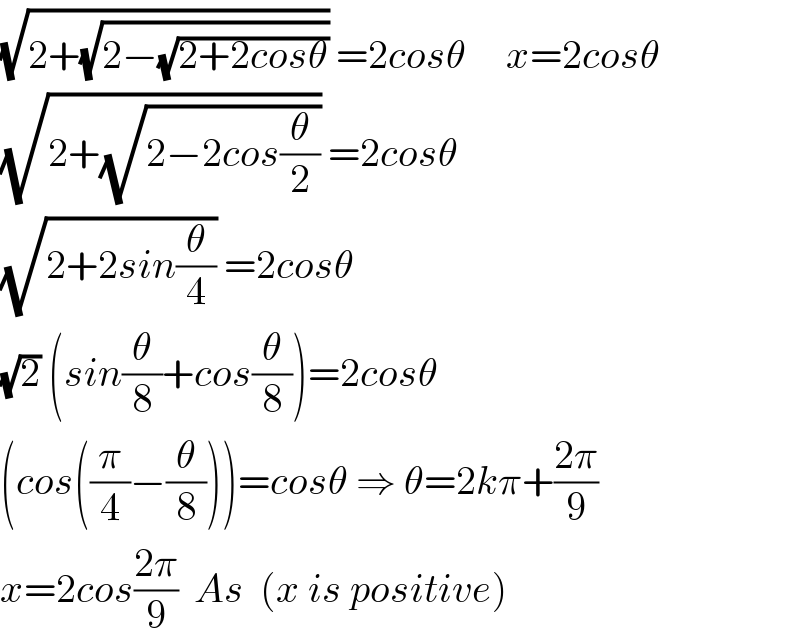Question Number 123210 by Khalmohmmad last updated on 24/Nov/20

Answered by Lordose last updated on 24/Nov/20

$$ \\ $$$$\sqrt{\mathrm{2}+\sqrt{\mathrm{2}−\sqrt{\mathrm{2}+\mathrm{x}}}}\:=\:\mathrm{x} \\ $$$$\mathrm{2}+\sqrt{\mathrm{2}−\sqrt{\mathrm{2}+\mathrm{x}}}\:=\:\mathrm{x}^{\mathrm{2}} \\ $$$$\mathrm{2}−\sqrt{\mathrm{2}+\mathrm{x}}\:=\:\left(\mathrm{x}^{\mathrm{2}} −\mathrm{2}\right)^{\mathrm{2}} \\ $$$$\left(\mathrm{2}−\left(\mathrm{x}^{\mathrm{2}} −\mathrm{2}\right)^{\mathrm{2}} \right)^{\mathrm{2}} =\:\mathrm{2}\:+\:\mathrm{x} \\ $$$$\mathrm{x}^{\mathrm{8}} −\mathrm{8x}^{\mathrm{6}} +\mathrm{20x}^{\mathrm{4}} −\mathrm{16x}^{\mathrm{2}} +\mathrm{4}\:−\:\mathrm{2}\:−\:\mathrm{x}\:=\:\mathrm{0} \\ $$$$\mathrm{x}^{\mathrm{8}} −\mathrm{8x}^{\mathrm{6}} +\mathrm{20x}^{\mathrm{4}} −\mathrm{16x}^{\mathrm{2}} −\mathrm{x}+\mathrm{2}=\mathrm{0} \\ $$$$\left(\mathrm{x}+\mathrm{1}\right)\left(\mathrm{x}−\mathrm{2}\right)\left(\mathrm{x}^{\mathrm{6}} +\mathrm{x}^{\mathrm{5}} −\mathrm{5x}^{\mathrm{4}} −\mathrm{3x}^{\mathrm{3}} +\mathrm{7x}^{\mathrm{2}} +\mathrm{x}−\mathrm{1}\right)=\mathrm{0} \\ $$$$\mathrm{x}\:=\:−\mathrm{1}\:\mathrm{or}\:\mathrm{x}\:=\:\mathrm{2}\:\:\:\forall\:\left\{\mathrm{x}\in\mathbb{Z}\right\} \\ $$
Commented by MJS_new last updated on 24/Nov/20

$${x}=−\mathrm{1}\:\mathrm{must}\:\mathrm{be}\:\mathrm{wrong}\:\mathrm{because}\:\sqrt{{r}}=−\mathrm{1}\:\mathrm{has} \\ $$$$\mathrm{no}\:\mathrm{solution}\:\mathrm{in}\:\mathbb{C} \\ $$$${x}=\mathrm{2}\:\mathrm{leads}\:\mathrm{to}\:\sqrt{\mathrm{2}+\sqrt{\mathrm{2}−\sqrt{\mathrm{2}+\mathrm{2}}}}=\sqrt{\mathrm{2}+\sqrt{\mathrm{2}−\mathrm{2}}}=\sqrt{\mathrm{2}}\neq\mathrm{2} \\ $$$$\mathrm{as}\:\mathrm{you}\:\mathrm{should}\:\mathrm{know}\:\mathrm{squaring}\:\mathrm{introduces} \\ $$$$\mathrm{wrong}\:\mathrm{solutions} \\ $$
Commented by 676597498 last updated on 24/Nov/20

$${true} \\ $$
Commented by MJS_new last updated on 24/Nov/20

$${x}^{\mathrm{6}} +{x}^{\mathrm{5}} −\mathrm{5}{x}^{\mathrm{4}} −\mathrm{3}{x}^{\mathrm{3}} +\mathrm{7}{x}^{\mathrm{2}} +{x}−\mathrm{1}=\mathrm{0} \\ $$$$\left({x}^{\mathrm{3}} −\mathrm{3}{x}+\mathrm{1}\right)\left({x}^{\mathrm{3}} +{x}^{\mathrm{2}} −\mathrm{2}{x}−\mathrm{1}\right)=\mathrm{0} \\ $$$$\mathrm{solving}\:\mathrm{both}\:\mathrm{using}\:\mathrm{the}\:\mathrm{trigonometric}\:\mathrm{method} \\ $$$$\mathrm{and}\:\mathrm{testing}\:\mathrm{the}\:\mathrm{solutions}\:\mathrm{we}\:\mathrm{get} \\ $$$${x}_{\mathrm{1}} =−\mathrm{2cos}\:\frac{\pi}{\mathrm{9}}\:\mathrm{false} \\ $$$${x}_{\mathrm{2}} =\mathrm{2sin}\:\frac{\pi}{\mathrm{18}}\:\mathrm{false} \\ $$$${x}_{\mathrm{3}} =\mathrm{2cos}\:\frac{\mathrm{2}\pi}{\mathrm{9}}\:\mathrm{true} \\ $$$${x}_{\mathrm{4}} =−\frac{\mathrm{1}}{\mathrm{3}}−\frac{\mathrm{2}\sqrt{\mathrm{7}}}{\mathrm{3}}\mathrm{cos}\:\left(\frac{\pi}{\mathrm{6}}+\frac{\mathrm{1}}{\mathrm{3}}\mathrm{arcsin}\:\frac{\sqrt{\mathrm{7}}}{\mathrm{14}}\right)\:\mathrm{false} \\ $$$${x}_{\mathrm{5}} =−\frac{\mathrm{1}}{\mathrm{3}}−\frac{\mathrm{2}\sqrt{\mathrm{7}}}{\mathrm{3}}\mathrm{sin}\:\left(\frac{\mathrm{1}}{\mathrm{3}}\mathrm{arcsin}\:\frac{\sqrt{\mathrm{7}}}{\mathrm{14}}\right)\:\mathrm{false} \\ $$$${x}_{\mathrm{6}} =−\frac{\mathrm{1}}{\mathrm{3}}+\frac{\mathrm{2}\sqrt{\mathrm{7}}}{\mathrm{3}}\mathrm{sin}\:\left(\frac{\pi}{\mathrm{3}}+\frac{\mathrm{1}}{\mathrm{3}}\mathrm{arcsin}\:\frac{\sqrt{\mathrm{7}}}{\mathrm{14}}\right)\:\mathrm{false} \\ $$$$\Rightarrow\:{x}=\mathrm{2cos}\:\frac{\mathrm{2}\pi}{\mathrm{9}} \\ $$
Commented by Lordose last updated on 24/Nov/20

$$\mathrm{True} \\ $$$$\mathrm{Didn}'\mathrm{t}\:\mathrm{thought}\:\mathrm{that} \\ $$
Commented by Lordose last updated on 24/Nov/20

$$\mathrm{Thanks}\:\mathrm{sir} \\ $$
Commented by Khalmohmmad last updated on 24/Nov/20

$${Thanks}\:\:{sir} \\ $$
Answered by Dwaipayan Shikari last updated on 24/Nov/20

$$\sqrt{\mathrm{2}+\sqrt{\mathrm{2}−\sqrt{\mathrm{2}+\mathrm{2}{cos}\theta}}}\:=\mathrm{2}{cos}\theta\:\:\:\:\:{x}=\mathrm{2}{cos}\theta \\ $$$$\sqrt{\mathrm{2}+\sqrt{\mathrm{2}−\mathrm{2}{cos}\frac{\theta}{\mathrm{2}}}}\:=\mathrm{2}{cos}\theta \\ $$$$\sqrt{\mathrm{2}+\mathrm{2}{sin}\frac{\theta}{\mathrm{4}}}\:=\mathrm{2}{cos}\theta \\ $$$$\sqrt{\mathrm{2}}\:\left({sin}\frac{\theta}{\mathrm{8}}+{cos}\frac{\theta}{\mathrm{8}}\right)=\mathrm{2}{cos}\theta \\ $$$$\left({cos}\left(\frac{\pi}{\mathrm{4}}−\frac{\theta}{\mathrm{8}}\right)\right)={cos}\theta\:\Rightarrow\:\theta=\mathrm{2}{k}\pi+\frac{\mathrm{2}\pi}{\mathrm{9}} \\ $$$${x}=\mathrm{2}{cos}\frac{\mathrm{2}\pi}{\mathrm{9}}\:\:{As}\:\:\left({x}\:{is}\:{positive}\right) \\ $$
Commented by Khalmohmmad last updated on 24/Nov/20

$${Thanks}\:\:{sir} \\ $$
